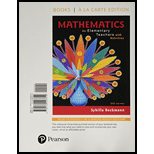
* Ms. Smith needs to figure her students’ homework grades. There have been 5 homework assignments: the first with 30 points, the second with 40 points, the third with 30 points, the fourth with 50 points, and the fifth with 25 points. Ms. Smith is debating between two different methods of calculating the homework grades.
Method 1: Add up the points scored on all 5 of the homework assignments, and divide by the total number of points possible. Then multiply by 100 to get the total score out of 100.
Method 2: Find the percentage correct on each homework assignment, and find the average of these five percentages.
a. Jodi’s homework grades are
b. Make up scores (on the same assignments) for Robert so that Robert scores higher with the other method than the one that gave Jodi the higher score.
Want to see the full answer?
Check out a sample textbook solution
Chapter 15 Solutions
Mathematics for Elementary Teachers with Activities, Books a la carte edition (5th Edition)
- Sketch the region of the integral dy dx. Write an equivalent double integral with the order of integration reversed. Do not solve the integral.arrow_forwardg Ske Find the area of the region bounded by the parabola x = 2y- y² + 1 and the line y = x + 1arrow_forward- | العنوان For the volume of the region in the first octant shown in the adjacent Figure. It is bounded by the coordinates planes, the plane: y = 1-x, and the surface:z = cos(лx/2), 0 ≤x≤1 Find the limits of integration for the two iterated integrals below: dz dx dy and dy dz dx Then find the volume of this region by only one of the above two iterated integrals. = cos(x/2) of y=1-xarrow_forward
- For the volume of the region in the first octant shown in the adjacent Figure. It is bounded by the coordinates planes, the plane: y = 1-x, and the surface:z = cos(лx/2), 0 ≤x≤1 Find the limits of integration for the two iterated integrals below: dz dx dy and dy dz dx Then find the volume of this region by only one of the above two iterated integrals. cos(x/2)/ y 1-xarrow_forwardNo chatgpt pls will upvotearrow_forwardFind the points of intersections of the function f(x) and its derivative. f(x)=(2x-3)√xarrow_forward
- C = (2√3)/3 or (-2√3)/3 within the interval (-2,2)arrow_forward4. [10 marks] Let T be the following tree: Find a graph G whose block graph BL(G) is isomorphic to T. Explain why your answer is correct.arrow_forward5. [10 marks] Determine whether the graph below has a perfect matching. Explain why your answer is correct. ข พarrow_forward
- (c) Utilize Fubini's Theorem to demonstrate that E(X)= = (1- F(x))dx.arrow_forward(c) Describe the positive and negative parts of a random variable. How is the integral defined for a general random variable using these components?arrow_forwardLet k ≥ 1, and let G be a k-regular bipartite graph with bipartition X, Y . Prove that |X| is the minimum size of a vertex cover in G.arrow_forward

 College AlgebraAlgebraISBN:9781305115545Author:James Stewart, Lothar Redlin, Saleem WatsonPublisher:Cengage Learning
College AlgebraAlgebraISBN:9781305115545Author:James Stewart, Lothar Redlin, Saleem WatsonPublisher:Cengage Learning College Algebra (MindTap Course List)AlgebraISBN:9781305652231Author:R. David Gustafson, Jeff HughesPublisher:Cengage Learning
College Algebra (MindTap Course List)AlgebraISBN:9781305652231Author:R. David Gustafson, Jeff HughesPublisher:Cengage Learning Algebra: Structure And Method, Book 1AlgebraISBN:9780395977224Author:Richard G. Brown, Mary P. Dolciani, Robert H. Sorgenfrey, William L. ColePublisher:McDougal Littell
Algebra: Structure And Method, Book 1AlgebraISBN:9780395977224Author:Richard G. Brown, Mary P. Dolciani, Robert H. Sorgenfrey, William L. ColePublisher:McDougal Littell Glencoe Algebra 1, Student Edition, 9780079039897...AlgebraISBN:9780079039897Author:CarterPublisher:McGraw Hill
Glencoe Algebra 1, Student Edition, 9780079039897...AlgebraISBN:9780079039897Author:CarterPublisher:McGraw Hill Holt Mcdougal Larson Pre-algebra: Student Edition...AlgebraISBN:9780547587776Author:HOLT MCDOUGALPublisher:HOLT MCDOUGAL
Holt Mcdougal Larson Pre-algebra: Student Edition...AlgebraISBN:9780547587776Author:HOLT MCDOUGALPublisher:HOLT MCDOUGAL





